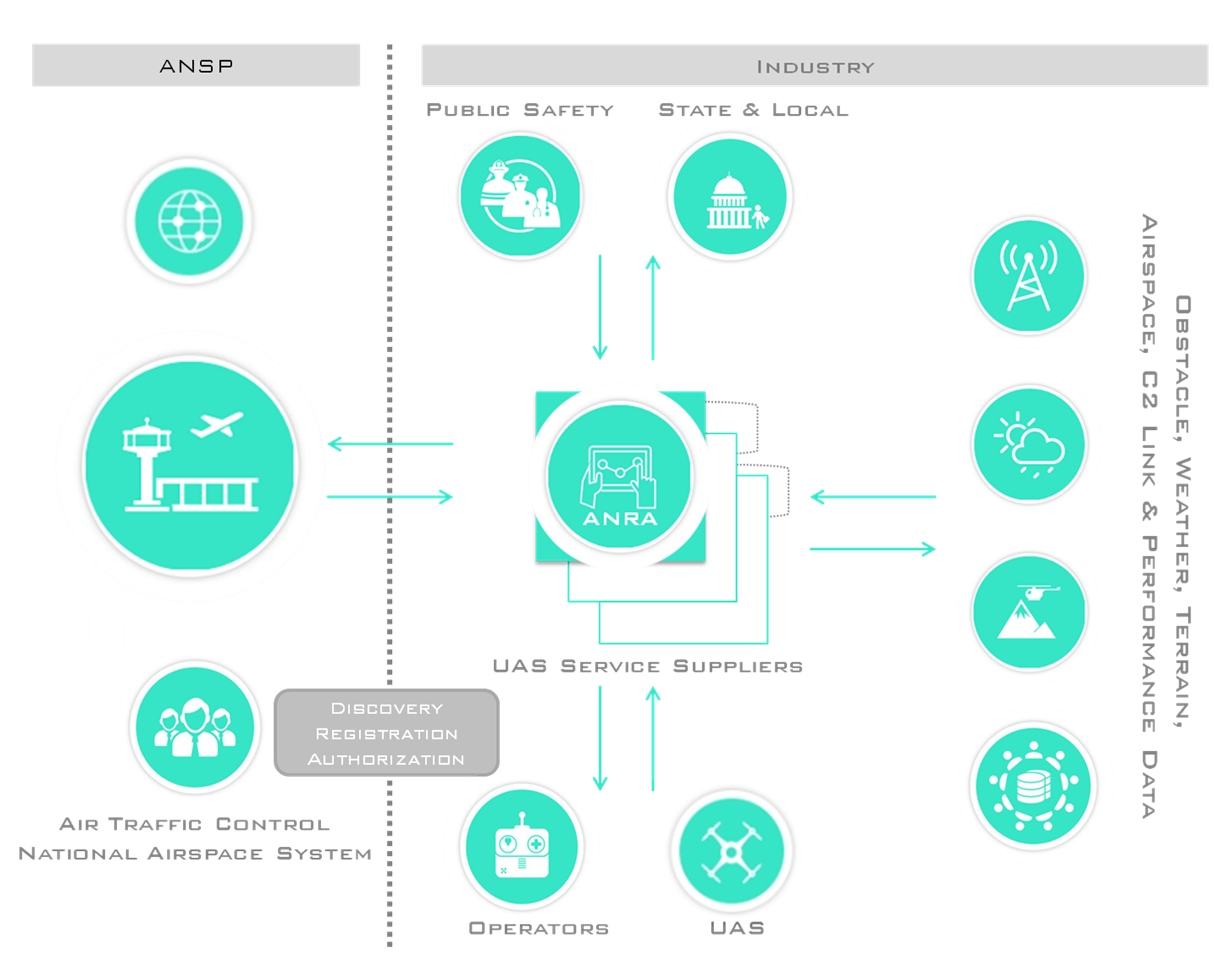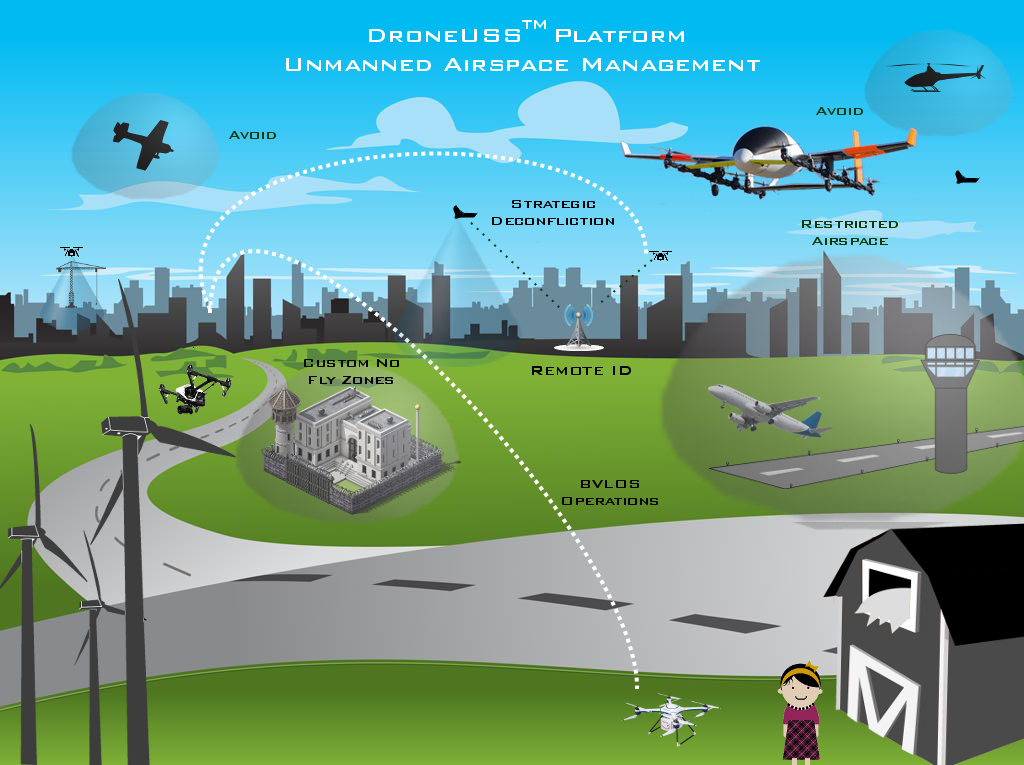The potential impact drones can have on projects of all types and sizes has been explored in great detail, but challenges remain when it comes to seeing this potential realized. It’s one thing to talk about how drones can make a given task faster cheaper or safer, but how will doing so impact or change established workflows? What will it mean to integrate drones and the data they capture into established processes?
These sorts of challenges were ones that
ANRA Technologies was specifically created to address. The founders had experienced integration challenges when utilizing drone programs for the DoD around workflow orchestrations as well as drone traffic management. They built a quick and dirty prototype solution that got the attention of the entire industry, and that compelled the ANRA leadership team to get serious about the technology. It led to the creation of their
DroneOSS Platform, which pulls in drone fleet management, command and control as well flight planning into a single platform.

Amit Ganjoo
As the CEO and Founder of ANRA Technologies,
Amit Ganjoo forms a critical part of that leadership team, and he’s
spoken and
written about where and how ANRA solutions are making a difference for commercial operators of all types. We wanted to connect with him to further talk through some of those details, but also asked him about how his solution fits into the drone ecosystem, what it will mean to create a UAS traffic management (UTM) system and much more.
Jeremiah Karpowicz: You mentioned that communications and data management ties directly into your background. How has that background directly or indirectly impacted the development of solutions like DroneOSS?Amit Ganjoo: It has been directly impacted since we took the concept of OSS from Telecommunications based on my past experience working with Ericsson. For commercial drone usage for enterprises, there is no one size first all solution that works. You have N different systems that need to work together to orchestrate the whole workflow. These systems are generally from different vendors and handle different parts of the solution. DroneOSS ™ platform creates an abstraction layer and in simple terms replaces N element level manages with one Network level manager which handles everything from flight planning, flight execution, sensor management, data capture and data analytics.
What makes DroneOSS distinct or different from some of the other drone flight management softwares that are out there?It is all about the open interfaces and flexibility on picking and choosing the components that best meet the enterprise and using DroneOSS ™ to orchestrate the workflow. There is no need to use a canned proprietary solution when you have the flexibility to tailor the workflow using a horizontal platform like DroneOSS ™. Using our system you can choose a drone you want, sensor you want, data analytics engine you want and the system will let you orchestrate the whole workflow from one single interface
Have you seen changes throughout any specific industries in terms of how they’re adopting drones? Do you see the technology opening up inherently different or more lucrative opportunities in one sector versus another? We are seeing a higher uptake in critical infrastructure, construction and energy segments. There are applications in pretty much most of the verticals out there but the industries listed above are the ones we see are leaning forward trying innovative use of drones.
Your three pillars for commercial drone applications explains how mission management, traffic management and data management are all essential parts of a drone ecosystem. How does DroneOSS tie all of these elements together in a simple way for users? DroneOSS ™ with all of its open interfaces and micro services acts as glue and ties all the components ranging from the Drone, Flight planning software, Flight Control, sensor control, data analytics and integration into the enterprise in one seamless flow. An enterprise can manages their whole workflow using one interface vs “N” different interfaces. This is the concept from the wireless industry.
What are some of the challenges you’ve seen operators run into when they don’t consider one or more of these three pillars? [Amit] The users end up getting what we in DoD used to call “Stovepipe” solutions. These are proprietary solutions that tie the enterprise into one hardware or software vs allowing the flexibility of picking and choosing the components that best work for the enterprise business and specific vertical
Those pillars are directly tied into the creation of a UAS traffic management (UTM) system that does not require constant human monitoring and surveillance and can still ensure the safety, security, and control of drones in low-altitude airspace. Are the challenges with the creation of this kind of system more about technology, policy, or something else?There are some technical challenges that exist but all of them can be solved if all the stakeholders can agree on an approach. The key challenges are certainly around the policy and regulations. In addition there are differing opinions on how and how much data to share with various UTM stakeholders between various industry leaders which make the things a bit more complicated.
What kind of overlap do you envision this kind of system will have with and for state and local agencies?The platform has to support interfaces for state and local as shown the figure below. This may range for public portal for remote identification of the drone or the ability to inject dynamic restrictions in the system or create custom non fly zones
 Remote ID is a big part of UTM, but many drone hobbyists are opposed to being part of this kind of ecosystem. Is there a middle ground around this issue?
Remote ID is a big part of UTM, but many drone hobbyists are opposed to being part of this kind of ecosystem. Is there a middle ground around this issue? At the end of the day the UTM system will have both cooperative and non-cooperative drones and different mechanisms will be used to track all of them. However, in my opinion the hobby drones should still be held accountable for broadcasting a remote ID, especially if they are flying in the same airspace as other commercial operations. However if a hobbyist is flying a drone in a designated drone zone, such as a RC park, maybe that requirement can be waived
Organizations in America (NASA) and Europe (GUTMA) are working to create UTM systems, but these efforts don’t always overlap. Does that create more challenges or opportunities? In many cases it does create challenges but a key thing to note is the NASA is a research organization and GUTMA is an Industry association. An entity like GUTMA can make recommendations but it will eventually be standards organizations such as ASTM, ANSI etc that will standardize the technical requirements.
Another challenge is the difference in how ANSPs operate around the world ranging from taking a centralized vs federated UTM approach.
How should drone operators balance their interest and investment of time around concepts like UTM that will be relevant tomorrow, versus workflow and data logistics that enable the technology to make a bottom line difference for them today?I believe the operators should focus on workflow orchestration but select platforms and services that they know are designed for handling scale and associated traffic management and integration into the NAS when the time comes. Operators should not get tied into system/platforms that will require a forklift say 2 years from now.
Does your product bridge the gap between the logistical concerns users are sorting through today with ones they’ll need to be cognizant of as UTM systems become more fully developed? Yes, it does which is why we offer two platforms, DroneOSS ™ which is a workflow orchestration platform and DroneUSS ™ which is the UTM system. Both the system are modular and expose extensive APIs and micro-services that allow integration between the two and well as any other third party systems/platforms that the enterprise might decide to use and allow for seamless integration.
What’s one thing you’re looking forward to seeing changed or developed in the near future that take efforts to create the kind of UTM system we’ve been talking about to the next level? I believe the development or more complex deconfliction and negotiation methodologies would be a great as they pave the way for a more robust UTM system and efficient use of airspace that we have available.

 Remote ID is a big part of UTM, but many drone hobbyists are opposed to being part of this kind of ecosystem. Is there a middle ground around this issue? At the end of the day the UTM system will have both cooperative and non-cooperative drones and different mechanisms will be used to track all of them. However, in my opinion the hobby drones should still be held accountable for broadcasting a remote ID, especially if they are flying in the same airspace as other commercial operations. However if a hobbyist is flying a drone in a designated drone zone, such as a RC park, maybe that requirement can be waived Organizations in America (NASA) and Europe (GUTMA) are working to create UTM systems, but these efforts don’t always overlap. Does that create more challenges or opportunities? In many cases it does create challenges but a key thing to note is the NASA is a research organization and GUTMA is an Industry association. An entity like GUTMA can make recommendations but it will eventually be standards organizations such as ASTM, ANSI etc that will standardize the technical requirements.Another challenge is the difference in how ANSPs operate around the world ranging from taking a centralized vs federated UTM approach. How should drone operators balance their interest and investment of time around concepts like UTM that will be relevant tomorrow, versus workflow and data logistics that enable the technology to make a bottom line difference for them today?I believe the operators should focus on workflow orchestration but select platforms and services that they know are designed for handling scale and associated traffic management and integration into the NAS when the time comes. Operators should not get tied into system/platforms that will require a forklift say 2 years from now. Does your product bridge the gap between the logistical concerns users are sorting through today with ones they’ll need to be cognizant of as UTM systems become more fully developed? Yes, it does which is why we offer two platforms, DroneOSS ™ which is a workflow orchestration platform and DroneUSS ™ which is the UTM system. Both the system are modular and expose extensive APIs and micro-services that allow integration between the two and well as any other third party systems/platforms that the enterprise might decide to use and allow for seamless integration. What’s one thing you’re looking forward to seeing changed or developed in the near future that take efforts to create the kind of UTM system we’ve been talking about to the next level? I believe the development or more complex deconfliction and negotiation methodologies would be a great as they pave the way for a more robust UTM system and efficient use of airspace that we have available.
Remote ID is a big part of UTM, but many drone hobbyists are opposed to being part of this kind of ecosystem. Is there a middle ground around this issue? At the end of the day the UTM system will have both cooperative and non-cooperative drones and different mechanisms will be used to track all of them. However, in my opinion the hobby drones should still be held accountable for broadcasting a remote ID, especially if they are flying in the same airspace as other commercial operations. However if a hobbyist is flying a drone in a designated drone zone, such as a RC park, maybe that requirement can be waived Organizations in America (NASA) and Europe (GUTMA) are working to create UTM systems, but these efforts don’t always overlap. Does that create more challenges or opportunities? In many cases it does create challenges but a key thing to note is the NASA is a research organization and GUTMA is an Industry association. An entity like GUTMA can make recommendations but it will eventually be standards organizations such as ASTM, ANSI etc that will standardize the technical requirements.Another challenge is the difference in how ANSPs operate around the world ranging from taking a centralized vs federated UTM approach. How should drone operators balance their interest and investment of time around concepts like UTM that will be relevant tomorrow, versus workflow and data logistics that enable the technology to make a bottom line difference for them today?I believe the operators should focus on workflow orchestration but select platforms and services that they know are designed for handling scale and associated traffic management and integration into the NAS when the time comes. Operators should not get tied into system/platforms that will require a forklift say 2 years from now. Does your product bridge the gap between the logistical concerns users are sorting through today with ones they’ll need to be cognizant of as UTM systems become more fully developed? Yes, it does which is why we offer two platforms, DroneOSS ™ which is a workflow orchestration platform and DroneUSS ™ which is the UTM system. Both the system are modular and expose extensive APIs and micro-services that allow integration between the two and well as any other third party systems/platforms that the enterprise might decide to use and allow for seamless integration. What’s one thing you’re looking forward to seeing changed or developed in the near future that take efforts to create the kind of UTM system we’ve been talking about to the next level? I believe the development or more complex deconfliction and negotiation methodologies would be a great as they pave the way for a more robust UTM system and efficient use of airspace that we have available.














Comments